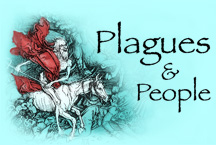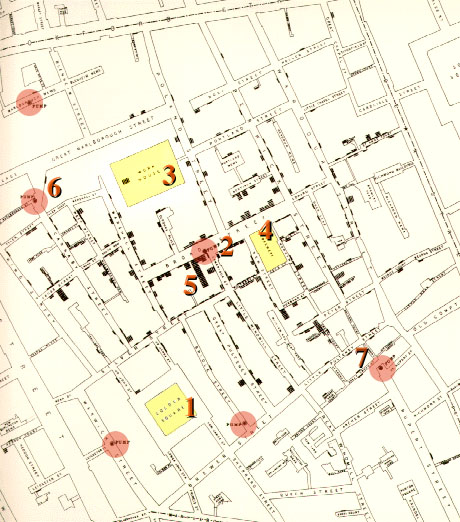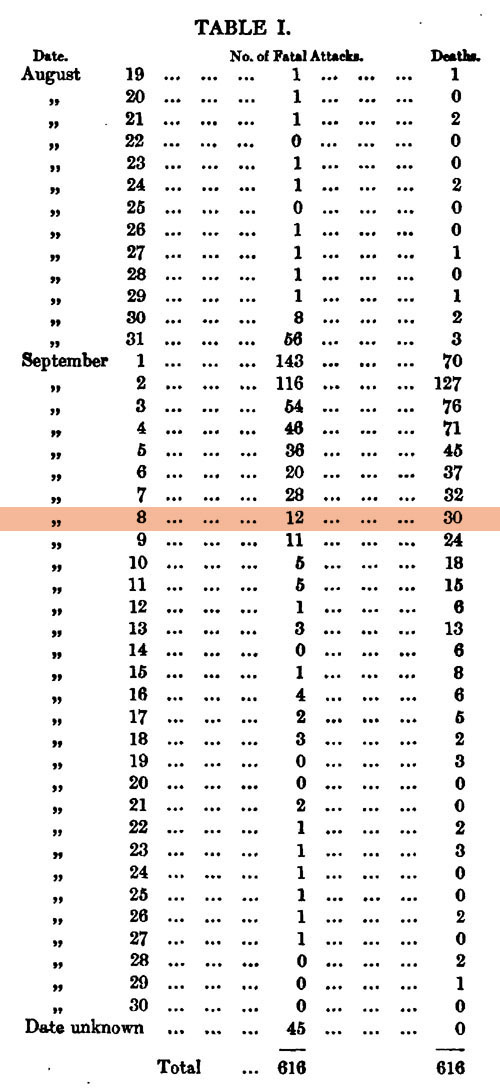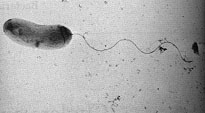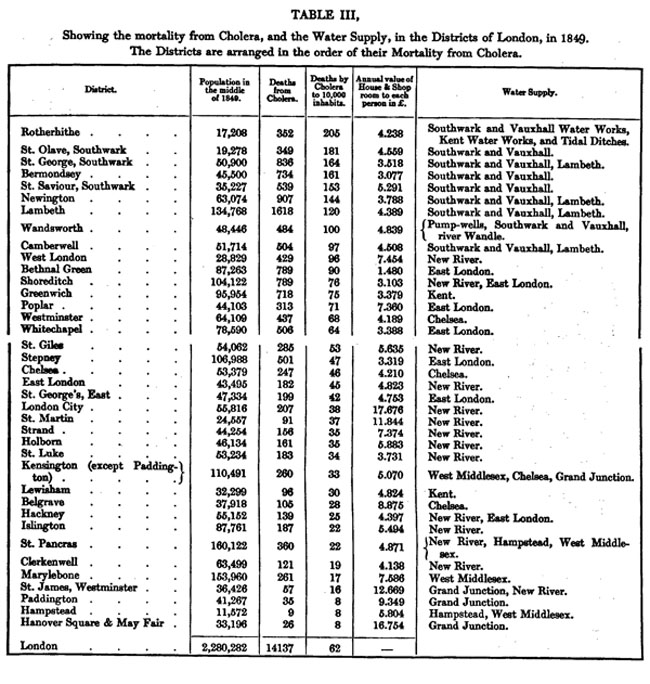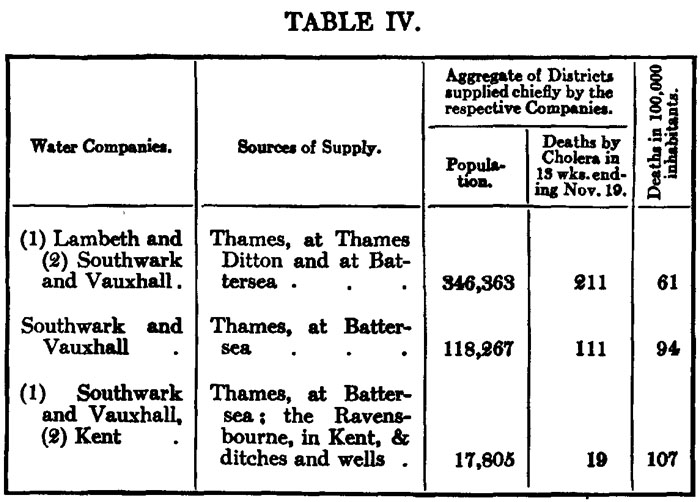| Intimate Mixture of the Water Supply of the Lambeth with That of
the Southwark and Vauxhall Company
[T]he intermixing of the water supply of the Southwark and Vauxhall Company
with that of the Lambeth Company, over an extensive part of London, admitted
of the subject being sifted in such a way as to yield the most incontrovertible
proof on one side or the other....
The pipes of each Company go down all the streets, and into nearly all
the courts and alleys. A few houses are supplied by one Company and
a few by the other, according to the decision of the owner or occupier
at that time when the Water Companies were in active competition.
In many cases a single house has a supply different from that on either
side. Each company supplies both rich and poor, both large houses
and small; there is no difference either in the condition or occupation
of the persons receiving the water of the different Companies.
Now it must be evident that, if the diminution of cholera, in the
districts partly supplied with the improved water, depended on this supply,
the houses receiving it would be the houses enjoying the whole benefit
of the diminution of the malady, whilst the houses supplied with the water
from Battersea Fields would suffer the same mortality as they would if
the improved supply did not exist at all.
As there is no difference whatever, either in the houses or the people
receiving the supply of the two Water Companies, or in any of the physical
conditions with which they are surrounded, it is obvious that no experiment
could have been devised which would more thoroughly test the effect of
water supply on the progress of cholera than this, which circumstances
placed ready made before the observer.
Opportunity Thus Afforded of Gaining Conclusive Evidence of the Effect
of the Water Supply on the Mortality from Cholera
The experiment, too, was on the grandest scale. No fewer than three
hundred thousand people of both sexes, of every age and occupation, and
of every rank and station, from gentlefolks down to the very poor, were
divided into two groups without their choice, and, in most cases, without
their knowledge; one group being supplied with water containing the sewage
of London, and, amongst it, whatever might have come from the cholera patients,
the other group having water quite free from such impurity.
To turn this grand experiment to account, all that was required was
to learn the supply of water to each individual house where a fatal attack
of cholera might occur....
I commenced my inquiry about the middle of August with two sub-districts
of Lambeth, called Kennington, first part, and Kennington, second part.
There were forty-four deaths in these sub-districts down to 12th August,
and I found that thirty-eight of the houses in which these deaths occurred
were supplied with water by the Southwark and Vauxhall Company, four houses
were supplied by the Lambeth Company, and two had pump-wells on the premises
and no supply from either of the Companies.
Account of the Inquiry for Obtaining This Evidence
...I pursued my inquiry over the various other sub-districts of Lambeth,
Southwark, and Newington, where the supply of the two Water Companies is
intermixed, with a result very similar to that already given....
The inquiry was necessarily attended with a good deal of trouble. There
were very few instances in which I could at once get the information I
required. Even when the water-rates are paid by the residents, they
can seldom remember the name of the Water Company till they have looked
for the receipt. In the case of working people who pay weekly rents,
the rates are invariably paid by the landlord or his agent, who often lives
at a distance, and the residents know nothing about the matter. It
would, indeed, have been almost impossible for me to complete the inquiry,
if I had not found that I could distinguish the water of the two companies
with perfect certainty by a chemical test....
Result of the Inquiry as Regards the First Four Weeks of the Epidemic
of 1854
...There were three hundred and thirty-four deaths from cholera in these
four weeks, in the districts to which the water supply of the Southwark
and Vauxhall and the Lambeth Company extends. Of these it was ascertained,
that in two hundred and eighty-six cases the house where the fatal attack
of cholera took place was supplied with water by the Southwark and Vauxhall
Company, and in only fourteen cases was the house supplied with the Lambeth
Company's water; in twenty-two cases the water was obtained by dipping
a pail directly into the Thames, in four instances it was obtained from
pump-wells, in four instances from ditches, and in four cases the source
of supply was not ascertained, owing to the person being taken ill whilst
traveling, or from some similar cause....
It is extremely worthy of remark, that whilst only five hundred and
sixty-three deaths from cholera occurred in the whole of the metropolis,
in the four weeks ending 5th August, more than one half of them took place
amongst the customers of the Southwark and Vauxhall Company, and a great
portion of the remaining deaths were those of mariners and persons employed
amongst the shipping in the Thames, who almost invariably draw their drinking
water direct from the river.
It may, indeed, be confidently asserted, that if the Southwark and Vauxhall
Water Company had been able to use the same expedition as the Lambeth Company
in completing their new works, and obtaining water free from the contents
of sewers, the late epidemic of cholera would have been confined in a great
measure to persons employed among the shipping, and to poor people who
get water by pailsful direct from the Thames or tidal ditches....
Result of the Inquiry ss Regards the First Seven Weeks of the Epidemic
of 1854
As the epidemic advanced, the disproportion between the number of cases
in houses supplied by the Southwark and Vauxhall Company and those supplied
by the Lambeth Company, became not quite so great, although it continued
very striking....
The following is the proportion of deaths to 10,000 houses, during the
first seven weeks of the epidemic, in the population supplied by the Southwark
and Vauxhall Company, in that supplied by the Lambeth Company, and in the
rest of London.
WATER SUPPLY AND CHOLERA DEATHS IN THE EPIDEMIC OF 1854
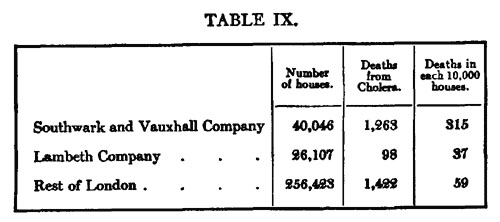
The mortality in the houses supplied by the Southwark and Vauxhall
Company was therefore between eight and nine times as great as in the houses
supplied by the Lambeth Company; and it will be remarked that the customers
of the Lambeth Company continued to enjoy an immunity from cholera greater
than the rest of London which is not mixed up as they are with the houses
supplied by the Southwark and Vauxhall Company....
Assent of the Medical Profession to the Influence of Polluted Water
on the Mortality from Cholera
After the Registrar-General alluded, in the "Weekly Return" of 14th October
last, to the very conclusive investigation of the effects of polluted water
in the south districts of London, there was a leading article, in nearly
all the medical periodicals, fully admitting the influence of the water
on the mortality from cholera. It may therefore be safely concluded
that this influence is pretty generally admitted by the profession.
It must not be disguised, however, that medical men are not yet generally
convinced that the disease is actually communicated from person to person
by the morbid matter being swallowed in the drinking water, or otherwise.
It used to be the custom of medical authors to speak of three kinds
of causes of a disease, viz. predisposing, exciting, and proximate causes.
The proximate causes have been given up, as being the diseases themselves;
but authors still divide causes into predisposing and exciting ones.
It may be remarked, however, that in treating of certain communicable diseases,
the cause of which is thoroughly understood, as syphilis and the itch,
predisposing causes are never mentioned; and that they are rarely alluded
to in treating of smallpox, measles, and scarlet fever, whilst they continue
to be appealed to in explanation of the various continued fevers.
Now many medical men, whilst they admit the influence of polluted water
on the prevalence of cholera, believe that it acts by predisposing or preparing
the system to be acted on by some unknown cause of the disease existing
in the atmosphere or elsewhere. The following amongst other reasons
prove, however, that opinion cannot long halt here, and that, if the effect
of contaminated water be admitted, it must lead to the conclusion that
it acts by containing the true and specific cause of the malady....
Answers to Certain Objections
There are one or two objections to the mode of communication of cholera
which I am endeavouring to establish, that deserve to be noticed.
Messrs. Pearse and Marston state, in their account of the cases of cholera
treated at the Newcastle Dispensary in 1853, that one of the dispensers
drank by mistake some rice-water evacuation without any effect whatever.
In rejoinder to this negative incident, it may be remarked,
that several conditions may be requisite to the communication of cholera
with which we are as yet unacquainted.... Syphilis we know is only
communicable in its primary stage, and vaccine lymph must be removed at
a particular time to produce its proper effects. In the incident
above mentioned, the large quantity of the evacuation taken might even
prevent its action. It must be remembered that the effects of a morbid
poison are never due to what first enters the system, but to the crop or
progeny produced from this during a period of reproduction, termed the
period of incubation; and if a whole sack of grain, or seed of any kind,
were put into a hole in the ground, it is very doubtful whether any crop
whatever would be produced....
An objection that has repeatedly been made to the propagation of cholera
through the medium of water, is, that every one who drinks of the water
ought to have the disease at once.
This objection arises from mistaking the department of science
to which the communication of cholera belongs, and looking on it as a question
of chemistry, instead of one of natural history, as it undoubtedly is.
It cannot be supposed that a morbid poison, which has the property,
under suitable circumstances, of reproducing its kind, should be capable
of being diluted indefinitely in water, like a chemical salt; and therefore
it is not to be presumed that the cholera-poison would be equally diffused
through every particle of the water. The eggs of the tape-worm must
undoubtedly pass down the sewers into the Thames, but it by no means follows
that everybody who drinks a glass of the water should swallow one of the
eggs....
It is not necessary to oppose any other theories in order to establish
the principles I am endeavouring to explain, for the field I have entered
on was almost unoccupied. The best attempt at explaining the phenomena
of cholera, which previously existed, was probably that which supposed
that the disease was communicated by effluvia given off from the patient
into the surrounding air, and inhaled by others into the lungs; but this
view required its advocates to draw very largely on what is called predisposition,
in order to account for the numbers who approach near to the patient without
being affected, whilst others acquire the disease without any near approach.
It also failed entirely to account for the sudden and violent outbreaks
of the disease, such as that which occurred in the, neighbourhood of Golden
Square.
Another view having a certain number of advocates is, that cholera depends
on an unknown something in the atmosphere which becomes localized, and
has its effects increased by the gases given off from decomposing animal
and vegetable matters. This hypothesis is, however, rendered impossible
by the motion of the atmosphere, and, even in the absence of wind, by the
laws which govern the diffusion of aeriform bodies; moreover, the connection
between cholera and offensive effluvia is by no means such as to indicate
cause and effect; even in London, as was before mentioned, many places
where offensive effluvia are very abundant have been visited very lightly
by cholera, whilst ... comparatively open and cleanly districts ... have
suffered severely....
Mr. John Lea, of Cincinnati, has advanced what he calls a geological
theory of cholera. He supposes that the cholera poison, which he
believes to exist in the air about the sick, requires the existence of
calcareous or magnesian salts in the drinking-water to give it effect.
This view is not consistent with what we know of cholera, but there are
certain circumstances related by Mr. Lea which deserve attention.
He says that, in the western districts of the United States, the cholera
... attacked with deadly effect those who use ... calcareous water, while
it passed by those who used sandstone or soft water. He gives many
instances of towns suffering severely when river water was used, whilst
others, having only soft spring water or rain water, escaped almost entirely;
and he states that there has been scarcely a case of cholera in families
who used only rain water.
The rivers, it is evident, might be contaminated with the evacuations,
whilst it is equally evident that the rain water could not be so polluted.
As regards sand and all sandstone formations, they are well known to have
the effect of oxidizing and thus destroying organic matters; whilst the
limestone might not have that effect, although I have no experience on
that point. The connection which Mr. Lea has observed between cholera
and the water is highly interesting, although it probably admits of a very
different explanation from the one he has given.....
The Effect of Season on the Prevalence of Cholera
Each time when cholera has been introduced into England in the autumn,
it has made but little progress, and has lingered rather than flourished
during the winter and spring, to increase gradually during the following
summer, reach its climax at the latter part of summer, and decline somewhat
rapidly as the cool days of autumn set in. In most parts of Scotland, on
the contrary, cholera has each time run through its course in the winter
immediately following its introduction.
I have now to offer what I consider an explanation, to a great extent,
of these peculiarities in the progress of cholera. The English people,
as a general rule, do not drink much unboiled water, except in warm weather.
They generally take tea, coffee, malt liquor, or some other artificial
beverage at their meals, and do not require to drink between meals, except
when the weather is warm.
In summer, however, a much greater quantity of drink is required, and
it is much more usual to drink water at that season than in cold weather.
Consequently, whilst the cholera is chiefly confined in winter to the crowded
families of the poor, and to the mining population, who, as was before
explained, eat each other's excrement at all times, it gains access as
summer advances to the population of the towns, where there is a river
which receives the sewers and supplies the drinking water at the same time;
and, where pump-wells and other limited supplies of water happen to be
contaminated with the contents of the drains and cesspools, there is a
greater opportunity for the disease to spread at a time when unboiled water
is more freely used.
In Scotland, on the other hand, unboiled water is somewhat freely used
at all times to mix with spirits; I am told that when two or three people
enter a tavern in Scotland and ask for a gill of whiskey, a jug of water
and tumbler-glasses are brought with it. Malt liquors are only consumed
to a limited extent in Scotland, and when persons drink spirit without
water, as they often do, it occasions thirst and obliges them to drink
water afterwards.
There may be other causes besides the above which tend to assist the
propagation of cholera in warm, more than in cold weather. It is
not unlikely that insects, especially the common houseflies, aid in spreading
the disease....
Evidence That Plague, Yellow Fever, Dysentery, and Typhoid Fever
Are
Communicated in the Same Way as Cholera
Since the latter part of 1848, when I first arrived at my present conclusions
respecting the mode of communication of cholera, I have become more and
more convinced that many other diseases are propagated in the same way.
When the plague visited this country, it was most fatal in London, York,
Winchester, and certain other towns having a river of fresh water passing
through them. It resembled cholera also in being twice as fatal in
the districts on the south of the Thames as in those on the north....
Although some of the lower parts of the City were supplied with water
from the Thames, at the latter part of the sixteenth and throughout the
seventeenth century, yet the greater part of London north of the Thames
was supplied by fountains and conduits, conveying spring water from a distance....
The plague resembles cholera in being much promoted by crowding and
want of personal cleanliness....
Yellow fever, which has been clearly proved ... to be a communicable
disease, resembles cholera and the plague in flourishing best, as a general
rule, on low alluvial soil, and also in spreading greatly where there is
a want of personal cleanliness....
It was long ago observed, that dysentery was apparently propagated by
the drinking of water containing excrementitious matters. The frequent
appearance of this disease in Millbank prison, when the Thames water was
used, is a confirmation of this; and Dr. Bryson has lately related a number
of instances where both dysentery and fever seemed to be occasioned by
the water of the Yangtse-Kiang, the Canton river, and other rivers of China....
There are many facts which indicate that one at least of the continued
fevers--the typhoid fever with ulceration of the small intestines-- is also
propagated in the same way as cholera....
Instances in Which Ague [Malaria]Was Caused by Impure Water
Intermittent fevers are so fixed to particular places that they have deservedly
obtained the name of endemics. They spread occasionally, however,
much beyond their ordinary localities, and become epidemic. Intermittent
fevers are undoubtedly often connected with a marshy state of the soil;
for draining the land frequently causes their disappearance. They
sometimes, however, exist as endemics, where there is no marshy land or
stagnant water within scores of miles.
Towards the end of the seventeenth century, intermittent fevers were...
attributed ... to noxious effluvia arising from marshes. These supposed
effluvia, or marsh miasmata, as they were afterwards called, were thought
to arise from decomposing vegetable and animal matter; but, as intermittent
fevers have prevailed in many places where there was no decomposing vegetable
or animal matter, this opinion has been given up in a great measure; still
the belief in miasmata or malaria of some kind, as a cause of intermittents,
is very general. It must be acknowledged, however, that there is
no direct proof of the existence of malaria or miasmata, much less of their
nature.
That preventive of ague, draining the land, must affect the water of
a district quite as much as it affects the air, and there is direct evidence
to prove that intermittent fever has, at all events in some cases, been
caused by drinking the water of marshes....
Whether the unknown cause of ague has been produced in the system of
a previous patient, like the pus of smallpox and the eggs of tapeworm,
or whether it has been produced externally, there is, at present, no sufficient
evidence to show...
The communication of ague from person to person has not been observed,
and supposing this disease to be communicable, it may be so only indirectly,
for the materies morbi eliminated from one patient may require to undergo
a process of development or procreation out of the body before it enters
another patient, like certain flukes infesting some of the lower animals,
and procreating by alternate generations. |
